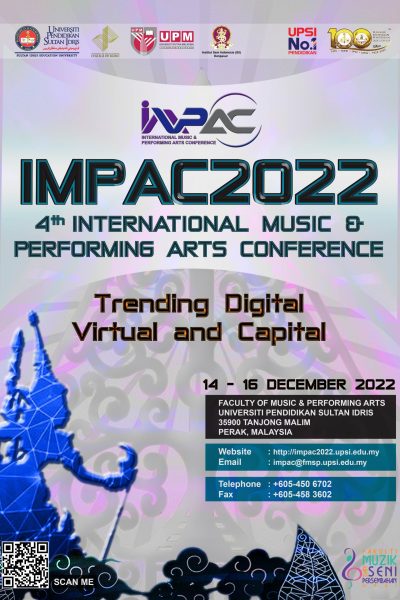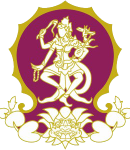4th INTERNATIONAL MUSIC AND PERFORMING ARTS CONFERENCE (IMPAC2022)

“TRENDING DIGITAL, VIRTUAL AND CAPITAL”
Faculty of Music and Performing Arts
Universiti Pendidikan Sultan Idris, Tanjong Malim, Perak, Malaysia
14-16 December 2022
The Faculty of Music and Performing Arts of Universiti Pendidikan Sultan Idris will hold their fourth (4th) International Music and Performing Arts Conference (IMPAC2022) from 14-16 December 2022. It will be an e-conference
Date : 14–16 December 2022
Time : 8:30 a.m.–6:00 p.m.
Host : Faculty of Music and Performing Arts
Universiti Pendidikan Sultan Idris
35900 Tanjong Malim, Perak, Malaysia
In collaboration with:



College of Music, University of the Philippines, Diliman, The Philippines
Music Department, Faculty of Ecology
Universiti Putra Malaysia
Institut Seni Indonesia (ISI) Denpasar
Bali, Indonesia
THEME
TRENDING DIGITAL, VIRTUAL AND CAPITAL
The term “performing arts” include music, dance, and theatre.
Themes
Performing Arts in Covid Era
The Performing Arts industry plays an important role in the economy and society— wellbeing, employment, sustainable development, tourism, and education. The global pandemic, Covid-19, has had tremendous effects on the Performing Arts grouped under the Cultural and Creative Industries. This theme explores how the Performing Arts sector is surviving the pandemic. How have musicians, producers, performances, and educators responded to the Covid-19 pandemic through performance and education? How do performers continue to practice and sustain their performance skills? What kind of creative work are composers, choreographers, thespians and producers producing during this time? How is the performing arts industry promoting and marketing performances? How do performing artists generate income during the pandemic? What are the teaching methods and approaches? What software, applications, and technological tools have been developed and utilized to engage online learners? How do educators deal with issues of online attention span; online connectivity; touch, sound, and movement during online teaching?
Sub-Themes
“Creative” Sustainability of Traditional Performing Arts
Traditional performing arts embody the evolving ideas of a group of people influenced by various forms of cultural contact- conquest, migration, colonization, assimilation, integration, and appropriation. Traditional performing arts consist of vast bodies of knowledge, skills, repertoire and techniques with their own value and aesthetics. Many of these traditional forms are less practiced today due to their detachment from a system of beliefs or an ecological niche. Many traditional forms of performance are also losing their appeal from competition with the capitalistic performing arts industry. How can musicians, composers, theatre practitioners, dancers and educators stimulate interest in traditional performing arts? Some traditional performing arts are being given new life through new approaches in education, production, and advocacy. What are the creative ideas utilized to capture and attract the online audiences? How can traditional performing arts be made relevant and interesting to the current generation? What are the critiques, problems, and issues with the approaches used? How have new belief systems, nationalistic propaganda, tourism, and “spectacle” influenced the cultural meaning and value the traditional performing arts? Who has the authority to change, accept, and approve these performances? How do these performances influence and affect consumer understanding and perception of the traditional performing arts?
Performing Arts Industries
The industrial revolution has changed the ways that humans create, consume, participate in, and listen to music, dance, and theatre. Some traditional performing arts have moved away from “traditional” religious, recreational, and therapeutic functions and are now often viewed as a commodity created by the recording, film, theatre, dance, and music industry. A work of art is now valued and measured by its ability to generate income or “likes”. The introduction of technology beginning with the emergence of electronic music led to infinite possibilities in sound and timbre production, creating new musical aesthetics such as mixing, EQing, phrasing, beatmatching and prep. Today, technology in the performing arts productions has expanded to the use of Augmented Reality, Artificial Intelligence and Virtual Reality. Individuals and groups can now market their performing arts productions through social media—Spotify, YouTube, Facebook, Instagram, Tik Tok and others. What happens to the performance of music, dance, and theatre when much of its production is focused on commoditization rather than inspiration; spectacle rather than function; entertainment rather than recreation? How does this affect the social psychology of the producers and consumers?
Diversifying Research Methodologies in the Performing Arts
In recent decades, performing arts researchers have been exploring new research methodologies to examine their own practices and creative works of arts. Approaches such as practice-led, practiced-based, artistic-led and a/r/tography have emerged. Performing artists are now integrating quantitative methodologies including surveys and experimental studies; with qualitative methods such as ethnography, case studies. Composers have collaborated with scientists to understand how musical sounds can affect the brain, facilitating music therapy research. Performers are collaborating with composers in understanding the limits and extent of the instrumentation that the composers would like to explore in their research. Performers are interviewing composers or examining historical documents from worldwide online resources now available for a refreshed understanding of existing repertoires.
Virtual performances
Virtual performances have revolutionized the creation and experience of performance. Composers, performers, dancer, theatre practitioners, and educators are challenged to create innovative ways to engage their virtual audience. Some events have utilized custom avatars, curated tracks, leaderboard challenges, prized games, award badges, virtual photo booths and prizes for those who stay till the end to attract audiences to remain engaged. How is scenography and lighting recreated; multiple camera angles, evolving virtual 3D backgrounds and random pop-ups advertisements introduced to create effects and affect moods? What are the methods, techniques and skills utilized to capture the attention of a virtual audience? How do these virtual performances affect the consumer’s experience of performance? How does watching from home and creating your own viewing setting and ambience create the performance experience?
Performing Gender
The gendering of sexed bodies is a process that shifts as people define themselves in particular cultural webs of local, national, and transnational ideologies. Performance contributes to cultural processes through which the boundaries of gender and sex are negotiated, constructed, and performed. The boundaries of gender and sex are cultural concepts and informed by ideologies that influence how gendered individuals should look, sound, move, behave, and dress. How are the boundaries of gender and sex being defined, redefined, or challenged through performance and the performing arts? Does the hyper real environment of virtual performance allow for explorations of gender identity not bound to physical bodies? How might gender and its definition affect the physical spaces of performance?

